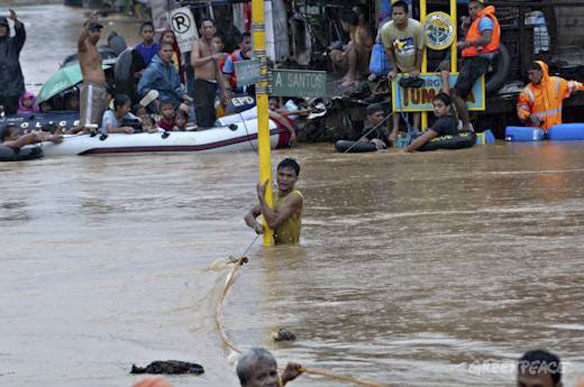
Manila flood. Photo source: ©© VJ Villafranca / Greenpeace
By Greenpeace;
Try and imagine what it would be like to wake up one day, look outside the window and discover that your home has disappeared.
This is what happened in Manila on Tuesday, when more than half of the sprawling metropolis was submerged in floodwaters.
The scenes of devastation were similar to the scenario depicted in the science fiction film “Waterworld”, but this was not a movie imagining the future. This was a reality.
Unusual rainfall reminiscent of Typhoon Ketsana, which struck in 2009, left more than 800,000 people stranded, homeless and without power. Dozens of deaths have been recorded since late July.
In some parts of Manila, the water level was neck-deep. More than half the amount of rain normally seen in August fell in the capital in just 24 hours, reports say.
People have been left stranded on their roofs, fleeing their homes and desperately taking their dogs on their shoulders or some of their valuables with them.
They are seeking refuge in schools and other community buildings as flood waters continue to rise.
Developing countries like the Philippines are considered the most vulnerable and least prepared to face the effects of climate change.
Extreme weather such as the storm that hit the Philippines in recent months has sparked debate among scientists about the potential link to climate change.
The debate escalated this week as James E. Hansen, a well-respected NASA climate scientist, published a scientific paper on Monday. These findings are also fuelling the current debate.
And yet, the reality is that unless decisive solutions are immediately put on the table, the worst is still in front of us.
There is strong scientific consensus that the intensity and frequency of extreme weather events, such as the drought that is also afflicting the American mid-west, are likely to increase under climate change.
Greenpeace strongly calls on industrialised countries, which account for most of the world’s greenhouse gas emissions, the greatest contributor to climate change, to take responsibility and curb their emissions.
Moreover, all nations must continue to develop and upgrade their climate change adaptation mechanisms at home…









